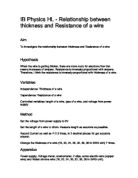Aim:
To calculate the diameter of a piece of nichrome wire from its electrical resistance by varying the length of the wire.
Background Information:
The resistance of a conductor can be found through the following equation:
Where: R = resistance (measured in Ω)
= length (measured in m)
= resistivity of material (measured in Ωm)
A = cross sectional area (m2)
The electrical resistivity of the nichrome wire is between 1.0x10-6 to 1.5x10 Ωm at room temperature (WireTron-Inc.). There is a range of electrical resistivity because nichrome wire is made out of nickel, chromium and often iron. Therefore, the compositions between the metals vary, thus the electrical resistance also vary. Therefore, the median of the range, 1.25x10-6 Ωm, will be used. The cross sectional area for a wire is . By substituting this in the equation and simplifying, the equation becomes:
If the resistance and length becomes the subject, the equation will be:
By making the resistance and length the subject, when graphed, the gradient will be equivalent to , and from this, the diameter can be determined.
Diagram of Apparatus:
Fig 1. Apparatus:
Raw Data:
Table 1. Quantitative Raw Data Table:
Sample calculations:
Processed Data:
Table 2. Quantitative Processed Data:
Graphing:
Graph 1. Average trendline of Length vs. Resistance:
Graph 2. Maximum and Minimum trendline of Length vs. Resistance:
More sample calculations:
Conclusion:
From the graphs 1 and 2 above, it is evident that the length is directly proportional to the resistance as the trendline is linear. From graph 1, the average gradient was found and from graph 2, the uncertainty of the average gradient was determined. The gradient can then be substituted into the equation and rearranged to find the diameter.
The diameter of the experiment was found to be 0.00055m with an uncertainty of ±0.00002m, where as the actual diameter is 0.000559m given by the manufacturer (Science Supplies Australia Pty, Ldt). From this, the experimental error can be calculated.
As shown above, the experimental error is 1.61%. This means that the difference between the experimental and theoretical value has a difference of 1.61%. This experimental error is less than the uncertainty. This also shows that the theoretical value lies within the uncertainty of the experimental result. Therefore, the experiment supports the relationship between the diameter, length and resistance, which is:
Which could be arranged to make diameter as the subject:
Sufficient concordant results were found in the experiment as the value between the maximum and minimum resistance found in the trails had the greatest difference of 0.2Ω. This shows that the results were consistent.
The method to calculating the uncertainty of the average resistance was maximum deviation. This method considers the greatest possible error in the experiment. The uncertainties were all found to be ±0.1Ω which is the same as the uncertainty of the instrument. Considering that the greatest possible error found for the average resistance was the same as the instrument, the error is considered to be quite low. The uncertainty of the length of nichrome wire was found using rules from error propagation.
The method of measuring the length required that the errors must be added together, therefore increasing the error in the experiment. This error can be improved if the nichrome was set up as a straight line and using a tape measure so that the error does not build up.
Evaluation:
Bibliography
(n.d.). Science Supplies Australia , 12.
WireTron-Inc. (n.d.). Nichrome 80 & Other Resistance Alloys - Technical Data & Properties. Retrieved February 13, 2012, from Wiretron: http://www.wiretron.com/nicrdat.html
Give your information a descriptive title to help the reader understand what you’re presenting
These are good graphs. Just try to give all your tables/graphs good, descriptive titles.
Explain why you made can claim this is so. (it’s true, just explain your evidence)
You need to consider the resistance of the cable leads you used to connect to the multimeter. These are probably your greatest source of systematic error.
Your recommendations are straight-forward and effective for the errors that you have identified.
Give your information a descriptive title to help the reader understand what you’re presenting








